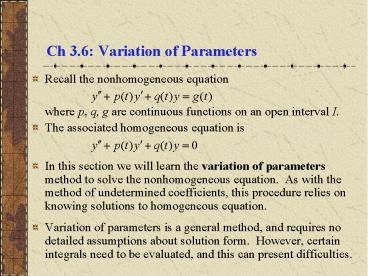Ch 3.6: Variation of Parameters PowerPoint PPT Presentation
Title: Ch 3.6: Variation of Parameters
1
Ch 3.6 Variation of Parameters
- Recall the nonhomogeneous equation
- where p, q, g are continuous functions on an
open interval I. - The associated homogeneous equation is
- In this section we will learn the variation of
parameters method to solve the nonhomogeneous
equation. As with the method of undetermined
coefficients, this procedure relies on knowing
solutions to homogeneous equation. - Variation of parameters is a general method, and
requires no detailed assumptions about solution
form. However, certain integrals need to be
evaluated, and this can present difficulties.
2
Example Variation of Parameters (1 of 6)
- We seek a particular solution to the equation
below. - We cannot use method of undetermined coefficients
since g(t) is a quotient of sin t or cos t,
instead of a sum or product. - Recall that the solution to the homogeneous
equation is - To find a particular solution to the
nonhomogeneous equation, we begin with the form - Then
- or
3
Example Derivatives, 2nd Equation (2 of 6)
- From the previous slide,
- As a modification to the assumption of the
solution, we further impose the following
condition on u1 and u2 to make the above
expression simpler and future the task easier - Then, are reduced to the
much simpler forms - and,
4
Example Two Equations (3 of 6)
- Recall that our differential equation is
- Substituting y'' and y into this equation, we
obtain - This equation simplifies to
- Thus, to solve for u1 and u2, we have the two
equations
5
Example Solve for u1' (4 of 6)
- To find u1 and u2 , we need to solve the
equations - From second equation,
- Substituting this into the first equation,
6
Example Solve for u1 and u2 (5 of 6)
- From the previous slide,
- Then
- Thus
7
Example General Solution (6 of 6)
- Recall our equation and homogeneous solution yC
- Using the expressions for u1 and u2 on the
previous slide, the general solution to the
differential equation is
8
Summary
- Suppose y1, y2 are fundamental solutions to the
homogeneous equation associated with the
nonhomogeneous equation above, where we note that
the coefficient on y'' is 1. - To find u1 and u2, we need to solve the equations
9
Summary
- Solving the equations directly to obtain
, or using the Wronskian, we may have
an explicit expression - Integrating ,we finally
obtain , or have the explicit formula
10
Theorem 3.7.1
- Consider the equations
- If the functions p, q and g are continuous on an
open interval I, and if y1 and y2 are fundamental
solutions to Eq. (2), then a particular solution
of Eq. (1) is - and the general solution is

